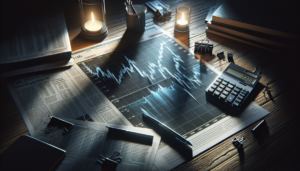The impact of natural disasters on financial markets can be significant and far-reaching. When catastrophic events like hurricanes, earthquakes, or tsunamis strike, they often lead to dramatic fluctuations in asset prices and overall market volatility. Understanding how stock prices typically react in the wake of a natural disaster is crucial for investors looking to navigate uncertain times.
Introduction to Natural Disasters and Stock Prices
Natural disasters are unpredictable events that can wreak havoc on economies and disrupt normal business operations. From damaged infrastructure to interrupted supply chains, the financial consequences can be severe.
Defining Natural Disasters
A natural disaster is a major adverse event caused by natural processes of the Earth. Examples include:
- Hurricanes and typhoons
- Earthquakes and tsunamis
- Floods and mudslides
- Wildfires and droughts
These catastrophes often result in significant property damage, loss of life, and economic disruption. The scale of destruction can send shockwaves through financial markets as investors grapple with uncertainty.
Overview of Stock Market Dynamics
The stock market is a complex system where share prices are determined by the forces of supply and demand. Multiple factors influence investor behavior and market sentiment, including:
- Economic indicators
- Company earnings
- Political events
- Natural disasters and wars
When external shocks like natural disasters occur, markets often experience heightened volatility as participants attempt to assess the potential fallout. Knee-jerk reactions can cause dramatic swings in asset prices in the immediate aftermath.
Immediate Impact of Natural Disasters on Stock Prices
In the days and weeks following a major disaster, stock markets tend to be dominated by fear and uncertainty. Investors may engage in panic selling, driving prices lower as they seek to limit their exposure to potentially affected companies and industries.
Market Volatility and Investor Reactions
Volatility typically spikes in the wake of a natural disaster as markets struggle to efficiently price in the new risk factors. Wide bid-ask spreads and sharp price movements characterize trading in the initial days post-disaster.
Investors often adopt a “sell first, ask questions later” mentality, which can lead to indiscriminate selling across the board. This phenomenon is especially true when disasters strike financial centers or major economic hubs.
Case Studies: Historical Reactions
History provides a few instructive examples of how natural disasters impact financial markets:
| Disaster | Date | Market Reaction |
|---|---|---|
| Hurricane Katrina | August 2005 | Dow drops 1.6% in the 5 days post-landfall |
| Japan’s Tohoku Earthquake & Tsunami | March 2011 | Nikkei plunges 17.5% in the 3 days post-disaster |
| Hurricane Sandy | October 2012 | U.S. exchanges closed for 2 days; flights grounded |
While the initial market reactions can be severe, they are often short-lived. Once the extent of the damage becomes clearer, oversold stocks frequently rebound as investors focus on the long-term recovery prospects.
Long-term Effects on Financial Markets
Although the initial shocks tend to be the most dramatic, natural disasters also leave lasting imprints on the financial world. Some economic consequences only become apparent in the months and years after the event.
Sustained Market Trends Post-Disaster
Once the initial panic subsides, certain longer-term trends tend to emerge in financial markets:
- Underperformance in directly impacted sectors (e.g. tourism, airlines)
- Outperformance in reconstruction-related industries (e.g. construction, materials)
- Risk premiums increase for companies in vulnerable geographies
Rational investors will often use the post-disaster period to selectively acquire shares in well-managed companies that are likely to be leaders in the rebuilding effort.
Impact on Different Asset Classes
Beyond equities, natural disasters affect the pricing of other financial assets as well:
- Bonds – Credit spreads may widen for municipal/corporate debt in affected regions
- Commodities – Supply disruptions can cause price spikes in raw materials, especially energy and agricultural products
- Real Estate – Property markets can soften in hard-hit areas; relocations boost prices in surrounding cities
Savvy investors need to understand how these ripple effects can create both risks and opportunities across asset classes.
Sector-Specific Impacts
The exact financial toll of a natural disaster depends heavily on the nature of the catastrophe and the industries most directly in its crosshairs. Two sectors that tend to find themselves squarely in the impact zone are energy/utilities and insurance.
Energy and Utilities
Hurricanes and earthquakes frequently lead to power outages and infrastructure damage. This can cause extended downtime for oil refineries, pipelines, transmission lines, and power plants.
In some cases, regional utilities may face financial strain or even bankruptcy due to disaster-related expenses. However, the rebuilding phase also creates opportunities for construction firms and equipment suppliers.
Insurance and Real Estate
Property and casualty insurers are another segment that catches the brunt of natural disaster costs. Widespread damage to homes and commercial buildings can lead to extensive claims losses for insurance companies.
While the large public insurers are well-capitalized and have reinsurance protection, smaller firms with geographically concentrated policy books may face severe financial stress after major catastrophes.
Strategies for Investors During Natural Disasters
Investors need to be prepared with a game plan of how to act when natural disasters inevitably strike again. By controlling emotions and focusing on a long-term strategy, it’s possible to both mitigate risks and capitalize on opportunities.
Risk Management and Diversification
The foundation of successfully navigating natural disaster risk is maintaining a well-diversified portfolio. Effective diversification spans across sectors, geographies, and asset classes.
Tactically reducing exposure to vulnerable sectors in advance of peak risk seasons (e.g. hurricane season) is one approach. Hedging with index put options or raising cash levels are other tools for the risk-averse.
Opportunities in Commodity Markets
While disasters are tragic events, they can also create imbalances in commodity markets that astute investors can position for. Classic examples are long trades in construction materials or energy futures after a major storm.
The key is to identify situations where the market has overreacted and created favorable risk/reward dynamics. In-depth research is essential to avoid value traps in firms facing real solvency issues.
Conclusion
Natural disasters are an unfortunate fact of life that can wreak havoc on people’s lives and have significant implications for financial markets. In the short-term, disasters frequently spark volatility and broad-based sell-offs as investors grapple with pricing in new risks.
However, for long-term investors who can see through temporary distress, there are often selective opportunities to acquire shares in high-quality companies at discounted valuations. Emphasis should be placed on firms with strong balance sheets and industry leadership positions.
Preparing in advance with a diversified portfolio and clear risk management parameters is essential. By understanding the nuances of how different disasters impact specific industries, investors can respond nimbly and rationally when others are gripped by fear.
See also:
- How Much is $1,000 Shares of Disney Stock Worth? Discover Your Investment Value
- How to Buy Atlanta Braves Stock: A Step-by-Step Guide
- What is a Stock Pot Used For? Discover Its Uses and Benefits
- Navigating the Future: The Role of Tokenization in Payments and Banking as a Service
- What Does a Stock Quote Represent? Understanding Its Meaning and Importance






